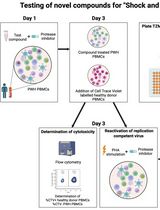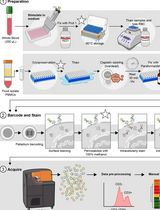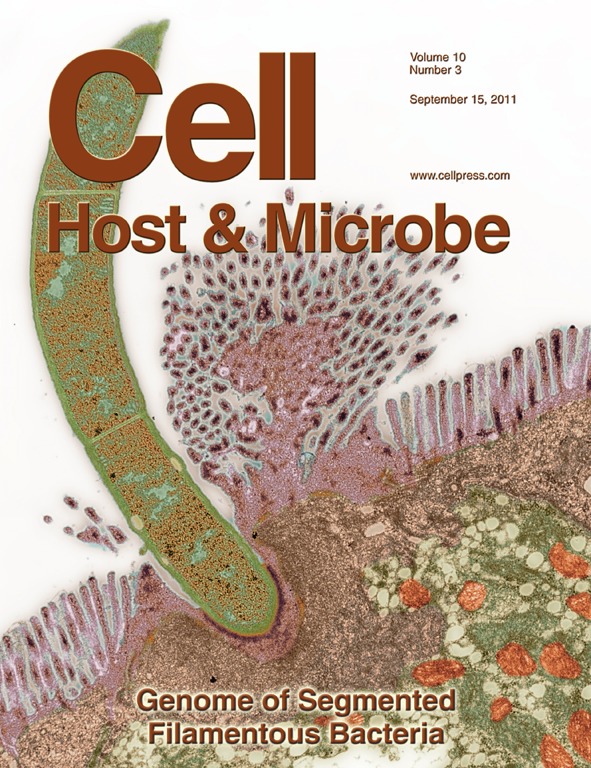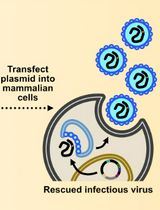- EN - English
- CN - 中文
Lentiviral Knockdown of Transcription Factor STAT1 in Peromyscus leucopus to Assess Its Role in the Restriction of Tick-borne Flaviviruses
慢病毒敲减白足鼠中转录因子STAT1以评价其在抑制蜱传黄病毒中的作用
发布: 2017年12月05日第7卷第23期 DOI: 10.21769/BioProtoc.2643 浏览次数: 11355
评审: Emilie BesnardFei XiaoJose Antonio Reyes-Darias

相关实验方案

诱导型HIV-1库削减检测(HIVRRA):用于评估外周血单个核细胞中HIV-1潜伏库清除策略毒性与效力的快速敏感方法
Jade Jansen [...] Neeltje A. Kootstra
2025年07月20日 2392 阅读

用于比较人冷冻保存 PBMC 与全血中 JAK/STAT 信号通路的双磷酸化 CyTOF 流程
Ilyssa E. Ramos [...] James M. Cherry
2025年11月20日 2129 阅读
Abstract
Cellular infection with tick-borne flaviviruses (TBFVs) results in activation of the interferon (IFN) signaling pathway and subsequent upregulation of numerous genes termed IFN stimulated genes (ISGs) (Schoggins et al., 2011). Many ISGs function to prevent virus pathogenesis by acting in a broad or specific manner through protein-protein interactions (Duggal and Emerman, 2012). The potency of the IFN signaling response determines the outcome of TBFV infection (Best, 2017; Carletti et al., 2017). Interestingly, data from our lab show that TBFV replication is significantly restricted in cells of the reservoir species Peromyscus leucopus thereby suggesting a potent antiviral response (Izuogu et al., 2017). We assessed the relative contribution of IFN signaling to resistance in P. leucopus by knocking down a major transcription factor in the IFN response pathway. Signal transducer and activator of transcription 1 (STAT1) was specifically targeted in P. leucopus cells by shRNA technology. We further tested the impact of gene knockdown on the ability of cells to respond to IFN and restrict virus replication; the results indicate that when STAT1 expression is altered, P. leucopus cells have a decreased response to IFN stimulation and are significantly more susceptible to TBFV replication.
Keywords: Interferon (干扰素)Background
IFN signaling is the first line of defense against flaviviruses invading a host cell (Robertson et al., 2009; Lazear and Diamond, 2015). Molecular signatures associated with the virus particles are detected by pattern-recognition receptors (PRRs) which then elicit downstream signaling via transcription factors to release type 1 IFNs from the cell (Kawai and Akira, 2011; Loo and Gale, 2011). Further, the IFN response pathway is initiated by binding of IFN-beta (IFN-β) to its cognate receptor and activation of the JAK-STAT signaling cascade (Loo et al., 2008). STAT1 is a major player in the IFN response pathway and functions within a complex to activate the IFN–stimulated response element (ISRE) promoter in the nucleus (Stark et al., 1998). Ultimately, IFN signaling transcriptionally upregulates numerous host genes that act to curtail infection and limit viral pathogenesis (Liu et al., 2011).
TBFVs contribute to the global burden of disease by causing encephalitis or hemorrhagic fevers in infected individuals. There are about 10,000 cases of TBE annually and disease is endemic to Europe and parts of Asia (Suss, 2008). In recent years, TBFVs have shown emerging nature due to their occurrence in previously unreported regions and re-occurrence in areas of eradication (Robertson et al., 2009; Ebel, 2010). The reason for the increased spread is not known, and treatment for clinically-recognized cases is limited to palliative care (Fernandez-Garcia et al., 2009; Lani et al., 2014). While virus infection in humans and other susceptible species can result in deleterious illness, infection of a natural reservoir host P. leucopus remains asymptomatic (Telford et al., 1997; Santos et al., 2016) suggesting that the host could lack relevant proviral factors or express effective antiviral factors. Data from our lab has explored these possibilities and demonstrated that viral restriction in P. leucopus cells is mediated by an antiviral response occurring via the IFN signaling cascade (Izuogu et al., 2017). Our studies involved resolving the sequence of antiviral gene homologs in P. leucopus and targeting components of the IFN response pathway. Specifically, our study first showed that STAT1 expression was consistently higher in P. leucopus cells compared to the susceptible control M. musculus following IFN treatment and virus infection (Izuogu et al., 2017). Based on these data, we further assessed the relative role of STAT1 in virus restriction by specific gene knockdown. This protocol describes the technique used to design shRNA to target STAT1, packaging into lentiviruses and cellular transduction to establish P. leucopus stable cell lines with diminished STAT1 expression. We further provide details of how these cells were assayed for a loss of restriction following infection with a TBFV, Langat virus (LGTV).
Materials and Reagents
- Materials
- Tissue culture plates (Greiner Bio One International, catalog numbers: 657160 , 662160 , 677180 –6, 24, and 48 wells respectively)
- Tissue culture flasks (Greiner Bio One International, catalog numbers: 658175 and 660175 –75 cm2 and 175 cm2 respectively)
- Eppendorf tubes (1.5 ml) (USA Scientific, catalog number: 1615-5510 )
- PVDF membranes (Thermo Fisher Scientific, catalog number: 88518 )
- Lightcycler 480 96-well plate (Roche Molecular Systems, catalog number: 04729692001 )
- Labtek slides (Thermo Fisher Scientific, catalog number: 154534 )
- 1.2 ml tubes (USA Scientific, catalog number: 1412-1000 )
- Autoradiography film (McKesson Medical-Surgical, catalog number: EBA45 )
- Coverslips (Fisher Scientific, catalog number: 12-545-88 )
- Reagent reservoir troughs (VistaLab, catalog number: 3054-1001 )
- Cell scraper (Fisher Scientific, catalog number: 08-100-241 )
- Airtight container (Sterilite, catalog number: 1642 )
- XCell4 SureLock Midi SDS-PAGE system (Thermo Fisher Scientific, InvitrogenTM, catalog number: WR0100 )
- 20-well Tris-Glycine midi gel (Thermo Fisher Scientific, InvitrogenTM, catalog number: WT0102BOX )
- Tissue culture plates (Greiner Bio One International, catalog numbers: 657160 , 662160 , 677180 –6, 24, and 48 wells respectively)
- Cells
- Human embryonic kidney (HEK)-293T cells (ATCC, catalog number: CRL-3216 )
- HEK-293 cells (ATCC, catalog number: CRL-1573 )
- African green monkey kidney cells–Vero cells (ATCC, catalog number: CCL-81 )
- P. leucopus adult skin fibroblast cells (Coriell Institute, catalog number: AG22353 )
- One ShotTM TOP10 Chemically-Competent E. coli cells (Thermo Fisher Scientific, InvitrogenTM, catalog number: C404010 )
- Human embryonic kidney (HEK)-293T cells (ATCC, catalog number: CRL-3216 )
- Viruses
Langat virus (LGTV) strain TP21 (kindly provided by Dr. Sonja M. Best, NIAID/NIH)
Note: LGTV is a naturally-attenuated member of the tick-borne flavivirus serocomplex used under biosafety level 2 (BSL2) laboratory conditions. All safety precautions for BSL2 level containment were adhered to. - Reagents
- pLENTI X2- DEST vector (Campeau et al., 2009)
- Recombinant mouse IFN-β (Pestka Biomedical Laboratories, catalog number: 12405-1 )
- Oligonucleotide primer pairs (see Table 1)
- RNAi BLOCK-iT U6 RNAi Entry Vector Kit (Thermo Fisher Scientific, InvitrogenTM, catalog number: K4945-00 )
- Agarose (BioExpress,, catalog number: E-3120-500 )
- 100 bp DNA ladder (New England Biolabs, catalog number: N3231L )
- TAE (10x) buffer (Thermo Fisher Scientific, InvitrogenTM, catalog number: 15558042 )
- 10x Tris-glycine SDS-PAGE running buffer (Thermo Fisher Scientific, InvitrogenTM, catalog number: LC2675 )
- LR Clonase II Enzyme Mix (Thermo Fisher Scientific, catalog number: 11791100 )
- ViraPowerTM Lentiviral Packaging Mix (Thermo Fisher Scientific, catalog number: K497500 )
- Lipofectamine 3000 (Thermo Fisher Scientific, InvitrogenTM, catalog number: L3000015 )
- Sodium butyrate (Sigma-Aldrich, catalog number: B5887 )
- Lenti-X GoStix (Takara Bio, Clontech, catalog number: 631244 )
- Polybrene (Sigma-Aldrich, catalog number: 107689 )
- Hygromycin B (Thermo Fisher Scientific, GibcoTM, catalog number: 10687010 )
- Phosphate buffered saline (PBS) (Thermo Fisher Scientific, InvitrogenTM, catalog number: QVC0508 ) alone or with 0.5% Tween-20 (PBST)
- iBlot transfer stacks (Thermo Fisher Scientific, InvitrogenTM, catalog number: IB4010-01 )
- Antibodies
- α-actin (Sigma-Aldrich, catalog number: A5441 )
- α-STAT1 (Cell Signaling Technology, catalog number: 9172S , used at 1:1,000) detects phosphorylation of STAT1 at Tyr701
- α-STAT1-P (Cell Signaling Technology, catalog number: 9167S , used at 1:1,000)
- α-LGTV E (provided by Dr. C. Schmaljohn, USAMRIID used at 1:1,000)
- α-LGTV NS3 (as described in Taylor et al., 2011, used at 1:2,000)
- Goat anti-mouse IgG (Thermo Fisher Scientific, catalog number: A28177 , used at 1:3,000 for immunoblotting and at 1:1,000 viral for immunofocus assays)
- Rabbit anti-chicken AlexaFluor 594 (Thermo Fisher Scientific, catalog number: A11042 , used at 1:1,000)
- Goat anti-mouse AlexaFluor 488 (Thermo Fisher Scientific, catalog number: A11029 , used at 1:1,000)
- α-actin (Sigma-Aldrich, catalog number: A5441 )
- ECL Plus (Thermo Fisher Scientific, PierceTM, catalog number: 80196 )
- RNeasy Mini Kit (QIAGEN, catalog number: 74104 )
- QuantiTect Reverse Transcription Kit (QIAGEN, catalog number: 205310 )
- PCR grade water (Thermo Fisher Scientific, InvitrogenTM, catalog number: AM9935 )
- Gene-specific qRT-PCR primers (see Table 2)
- FastStart essential DNA Green master (Roche Molecular Systems, catalog number: 06402712001 )
- Paraformaldehyde 16% w/v (Alfa Aesar, catalog number: 43368 )
- ProLong Gold Antifade Mountant with DAPI (Thermo Fisher Scientific, InvitrogenTM, catalog number: P36931 )
- Methanol
- Opti-MEM reduced serum medium (Thermo Fisher Scientific, catalog number: 31985062 )
- Tris (Fisher Scientific, catalog number: BP152-5 )
- Sodium chloride (NaCl) (Gentrox, catalog number: 60-037 )
- Deoxycholate (Sigma-Aldrich, catalog number: D6750 )
- 10x Tris-glycine buffer (Thermo Fisher Scientific, InvitrogenTM, catalog number: LC2672 )
- Sodium dodecyl sulfate (SDS) (Fisher Scientific, catalog number: BP166-500 )
- NP-40 (IGEPAL CA-630) (Sigma-Aldrich, catalog number: 542334 )
- Magnesium chloride hexahydrate (MgCl2·6H2O) (Avantor Performance Materials, MACRON, catalog number: 5958 )
- Calcium chloride (CaCl2) (Acros Organics, catalog number: 192735000 )
- 3,3-Diaminobenzidine HCl (Sigma-Aldrich, catalog number: D5637 )
- Hydrogen peroxide (H2O2) (Sigma-Aldrich, catalog number: H3410 )
- Glycerol (AMRESCO, catalog number: 0854 )
- Bromophenol blue (Bio-Rad Laboratories, catalog number: 1610404 )
- β-Mercaptoethanol (Alfa Aesar, catalog number: J61337 )
- Non-fat dry milk
- DMEM (Thermo Fisher Scientific, GibcoTM, catalog number: 12100061 )
- Methylcellulose (Fisher Scientific, catalog number: M352-500 )
- Fetal bovine serum (FBS) (Atlanta Biologicals, catalog number: S11550 )
- Triton X-100 ( Sigma Aldrich, catalog number: X100 )
- Sodium citrate (Sigma-Aldrich, catalog number: PHR1416 )
- Bovine serum albumin (BSA)
- Goat serum
- Quibit DNA BR kit (Thermo Fisher Scientific, InvitrogenTM, catalog number: Q32850 )
- Quibit RNA HS kit (Thermo Fisher Scientific, InvitrogenTM, catalog number: Q32852 )
- RNase-free DNase set (QIAGEN, catalog number: 79254 )
- Complete EDTA-free protease inhibitor cocktail (Thermo Fisher Scientific, PierceTM, catalog number: A32955 )
- Complete EDTA-free protease inhibitor cocktail (Roche Diagnostics, catalog number: 11873580001 )
- DC Protein assay reagents (Bio-Rad Laboratories, catalog number: 5000116 )
- Radioimmunoprecipitation assay (RIPA) buffer (see Recipes)
- DNase I buffer (10x) (see Recipes)
- Peroxidase substrate (prepared fresh) (see Recipes)
- 6x SDS-PAGE sample buffer (6x SB) (see Recipes)
- Western blot blocking solution (see Recipes)
- Culture overlay media (see Recipes)
- Permeabilization solution (see Recipes)
- Immunofluorescence assay blocking solution (see Recipes)
- pLENTI X2- DEST vector (Campeau et al., 2009)
Equipment
- Pipettes (USA Scientific)
- Transilluminator (Omega Ultra-Lum)
- Tabletop centrifuge (Eppendorf)
- iBlot dry blotting transfer machine (Thermo Fisher Scientific)
- Rocker (Benchmark)
- Rotator (Bellco Biotechnology)
- Autoradiography film processor (Kodak)
- Thermocycler (Roche Lightcycler)
- Tissue culture incubator (at 37 °C with 5% CO2) (Thermo Fisher Scientific)
- Biosafety cabinet
- Water bath (VWR Scientific)
- Heating block (at 95 °C) (Fisher Scientific)
- SDS-PAGE apparatus (Pharmacia Biotech)
- Refrigerator
- Vortex (Fisher Scientific)
- Qubit 2.0 fluorometer (Thermo Fisher Scientific, current model: Qubit 3.0 )
- Confocal microscope (Olympus Life Science)
Software
- GraphPad Prism 6: https://www.graphpad.com/scientific-software/prism/
- Roche Lightcycler 96 software: https://lifescience.roche.com/en_us/brands/realtime-pcr
- Invitrogen primer design software: https://rnaidesigner.thermofisher.com/rnaiexpress/
- MacVector software version 12.7: http://macvector.com/EcoRI/macvector12.7.5installer.html
Procedure
文章信息
版权信息
© 2017 The Authors; exclusive licensee Bio-protocol LLC.
如何引用
Izuogu, A. O. and Taylor, R. T. (2017). Lentiviral Knockdown of Transcription Factor STAT1 in Peromyscus leucopus to Assess Its Role in the Restriction of Tick-borne Flaviviruses. Bio-protocol 7(23): e2643. DOI: 10.21769/BioProtoc.2643.
分类
微生物学 > 微生物-宿主相互作用 > 病毒
免疫学 > 宿主防御 > 鼠
细胞生物学 > 细胞信号传导 > 胞内信号传导
您对这篇实验方法有问题吗?
在此处发布您的问题,我们将邀请本文作者来回答。同时,我们会将您的问题发布到Bio-protocol Exchange,以便寻求社区成员的帮助。
Share
Bluesky
X
Copy link










